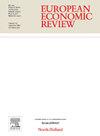劳动国家的财富
IF 2.8
2区 经济学
Q1 ECONOMICS
引用次数: 0
摘要
由于人口老龄化,在许多发达经济体,人均GDP增长与工作年龄成年人人均GDP增长(或每小时工作时间)之间的差距已经扩大。像日本这样的人均GDP增长乏力的国家,在每个工作年龄的成年人(或每工作小时)的GDP增长方面表现得出奇地好。尽管每个工作年龄的成年人的GDP水平存在显著差异,但许多发达经济体也在遵循类似的平衡增长路径。我们校准了一个标准的新古典增长模型,以反映每个经济体的工作年龄人口的变化。当我们匹配工作年龄成年人的人均GDP增长时,而不是匹配“标准”校准目标——人均GDP增长时,该模型与样本中所有经济体的数据更接近。本文章由计算机程序翻译,如有差异,请以英文原文为准。
The wealth of working nations
Due to aging populations, the gap between GDP growth per capita and GDP growth per working-age adult (or per hour worked) has widened in many advanced economies. Countries like Japan, which have shown lackluster GDP growth per capita, have performed surprisingly well in terms of GDP growth per working-age adult (or per hour worked). Many advanced economies are also following similar balanced growth paths per working-age adult despite significant differences in the levels of GDP per working-age adult. We calibrate a standard neoclassical growth model to reflect changes in the working-age population for each economy. This model aligns more closely with the data for all the economies in our sample when we match GDP growth per working-age adult rather than when we match GDP growth per capita, the “canonical” calibration target.
求助全文
通过发布文献求助,成功后即可免费获取论文全文。
去求助
来源期刊

European Economic Review
ECONOMICS-
CiteScore
4.70
自引率
3.60%
发文量
170
期刊介绍:
The European Economic Review (EER) started publishing in 1969 as the first research journal specifically aiming to contribute to the development and application of economics as a science in Europe. As a broad-based professional and international journal, the EER welcomes submissions of applied and theoretical research papers in all fields of economics. The aim of the EER is to contribute to the development of the science of economics and its applications, as well as to improve communication between academic researchers, teachers and policy makers across the European continent and beyond.
 求助内容:
求助内容: 应助结果提醒方式:
应助结果提醒方式:


